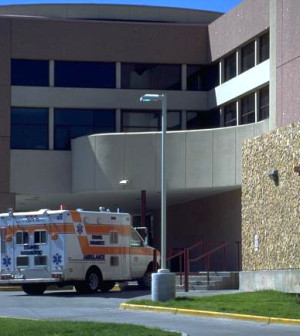- Bird Flu Virus in Canadian Teen Shows Mutations That Could Help It Spread Among Humans
- Flu, COVID Vaccination Rates Remain Low as Winter Nears
- ’10 Americas:’ Health Disparities Mean Life Expectancy Varies Across U.S.
- Short-Term Hormone Therapy for Menopause Won’t Harm Women’s Brains
- Could a Vitamin Be Effective Treatment for COPD?
- Woman Receives World’s First Robotic Double-Lung Transplant
- Flavored Vapes Behind Big Surge in U.S. E-Cigarette Sales
- Reading Beyond Headline Rare For Most on Social Media, Study Finds
- Meds Like Ozempic Are Causing Folks to Waste More Food
- Fibroids, Endometriosis Linked to Shorter Life Spans
Black Heart Attack Victims More Likely to Have Ambulance Diverted

Black heart attack patients are more likely than whites to have their ambulance diverted to another hospital due to overcrowding in the closest emergency department, a new study shows.
The researchers also found that long diversions reduced black patients’ chances of receiving specialized heart care and increased their risk of death within a year.
The study looked at 2001-11 Medicare data. The researchers included information on nearly 30,000 heart attack patients who were transported by ambulance to hospitals in 26 California counties.
Half the patients had no ambulance diversion, the study found. Another quarter had diversions lasting six hours or less, researchers said. Fifteen percent of heart attack patients had six to 12 hours of diversion, and 10 percent had more than 12 hours of diversion, the study said.
Diversions were more likely to occur for patients being taken to hospitals that served minorities — particularly those that served large numbers of black patients, according to the study.
Patients with more than 12 hours of ambulance diversion were:
- 4.4 percent less likely to be treated in cardiac care units
- 3.4 percent less likely to be treated in catheterization labs or facilities specializing in procedures to improve blood flow to the heart
- 4.3 percent less likely to receive catheterization
- 9.6 percent more likely to die during the following year.
The study was published recently in the journal BMJ Open.
“The take-home findings from this study are two-fold,” Dr. Renee Hsia, a professor of emergency medicine and health policy at the University of California, San Francisco, said in a university news release.
“First, we now better understand the mechanisms behind emergency department crowding and how it affects patients. Not only are crowded hospitals less able to deliver high-quality care, but even sick patients get diverted to hospitals with less technology. On top of that, they are less likely to receive appropriate treatment,” she said.
“Secondly, we have definitive evidence that minority-serving hospitals, or hospitals that serve a high proportion of black patients, tend to experience higher levels of emergency department crowding,” Hsia added.
Hsia hopes the findings from this study will help make system-wide changes.
“While focusing efforts to decrease emergency department crowding is necessary in all hospitals, it might be more ‘bang for the buck’ if we want to make a dent in decreasing disparities by targeting efforts in minority-serving hospitals,” Hsia concluded.
More information
The American Academy of Family Physicians has more about heart attack.
Source: HealthDay
Copyright © 2024 HealthDay. All rights reserved.



-120x134.jpg)




